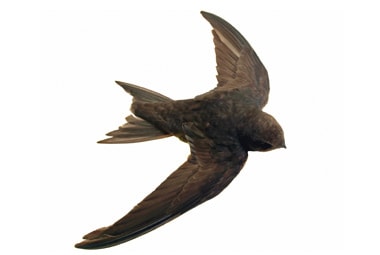
Chimney swifts are birds that spend almost their entire life flying in the air. Unlike most other bird species, chimney swifts are unable to perch, instead, they cling to vertical walls inside of hollow trees, caves, or as their name suggests chimneys. They are found throughout the eastern half of the United States.
| Pest Identification | |
|---|---|
| Biology | Chimney swifts are very small birds with adults only weighing about 1 ounce, and growing in length to be about 5 ½ inches. They are a dark grayish-brown in color with the feathers on their throat being slightly lighter in color. They have a slender cylindrical shaped body and very distinctive looking narrow, curved wings. Chimney swifts have a round head, very short neck, legs and tail, and a beak that is so short and wide that it almost appears non-existent. These birds are often described as a “cigar” with wings. Chimney swifts live for about 4-5 years and generally mate for life. Their nests are made from twigs, leaves, mud, and saliva. They stick their nests to the vertical surface of structures, mostly choosing chimneys. The female will lay 4-5 eggs and the young will hatch from the eggs after about 19 days. About a month after hatching, they will fly from the nest. |
| Habits | Chimney swifts are a very social species of birds and fly together in groups of two or three to hunt. They feed on a variety of different insects including flies, ants, bees, wasps, scale insects and airborne spiders. Chimney swifts do almost everything in the air from eating to drinking. They rarely stop to rest. They are very loud birds and are often heard chattering. If disturbed while they are resting they flap their wings loudly against their body as a warning or threat. |
| Damage | Chimney swifts are beneficial birds because they eat a wide variety of nuisance insects, but because they like to nest inside of chimneys they can become quite problematic for homeowners. Having birds roosting and nesting inside of your chimney can lead to problems with the effectiveness of your chimney. Their nests can affect the way air is drafted through the chimney. Along with being a danger inside of chimneys, they are very vocal birds and the adults and the young can be loud and become annoying to listen to in your home day after day. |
| Professional | Chimney swifts are federally protected under the Migratory Bird Treaty Act, and while the nests contain eggs and young it cannot be removed or disturbed without a depredation permit issued by the US Fish and Wildlife Service. Because they are a protected species little can be done to control these pest birds. If chimney swifts have made your chimney their nesting area all you can do is wait until the adults and young leave the nests. After the nests have been abandoned a Rottler technician can come to your home, scrape the nesting material out of your chimney, and then install a tight-fitting chimney caps to prevent future problems with these pest birds. |

